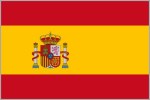
Elevated capital in the centre of mountainous Spain, all roads lead to Madrid

Capital of Spain and official residence of the King, Madrid is a very nice European city to visit. It is Europe‘s highest capital city at over two thousand feet elevation, and as a result has lovely fresh mountain air for much of the year. Where Barcelona is Spain’s pretty face for the tourists, Madrid is much more of a working Spanish city, much like Glasgow is to Edinburgh.
I have stayed in Madrid four times, and passed through on a few other occasions over the years, with my first visit in 2002 during which most of these photos were taken. My first accommodation was in a hostel near Plaza España, which for a fiver a night including breakfast delivered exactly the quality I expected. On that trip I used Madrid as a base to explore Toledo and Segovia as well, both within easy reach.

Philip III stands equestrian in the centre of Plaza Mayor, itself the centre of Madrid in the centre of Spain. There are usually plenty of entertainers and places to eat around the square, and it’s a great place for tapas and sangria. The building in the background is the Casa de la Panadería, or the Bakery House.
Plaza España, the next in the continuing series of Plazas in Madrid that we are working our way through. The three statues in the middle are of Don Quixote, Sanchopanza and Miguel de Cervantes who wrote the famous story about Quixote fighting the windmills. The building in the background is Edifício España, part of which is a hotel.


This is perhaps the most famous icon of Madrid, the statue El Oso y El Madroño, the bear eating fruit from a tree. It is the emblem of the city, from a time when bears were plentiful nearby. He stands at the east end of the Puerta del Sol, the de facto commercial centre of Madrid.
The Royal Palace of Madrid was built in the 18th century by Philip V, designed by Italian architects. It replaced the original which burnt down in 1734. This photo was taken from the gardens to the north of the palace, perhaps the most scenic view of the place as the building is generally quite forbidding. I tried to walk in the front door but was discretely turned away by polite men with guns.


The Opera House, right across the way from the Royal Palace, with the equestrian statue of Philip IV. The statue was cast from a design by Velázquez and is said to be one of the finest pieces of sculpture in Madrid, although I personally preferred the statues of Don Quixote and company in Plaza España.
The Monument to Alfonso XII in Buen Retiro Park, as seen whilst we peacefully boated across the adjacent lake. The monument was erected in the 1920s, but the park is much older, dating back to the 1500s.


The Temple of Debod looks slightly out of place in Madrid, having been relocated from its native ancient Egypt in 1968. However, unlike the Egyptian treasures in the British Museum, Debod was in fact gifted to Spain by Egypt during construction of the Aswan Dam, before the site was inundated by Lake Nasser.
This building caught me by surprise, I would have more likely expected a building called Metropolis to be located in New York. It was completed in 1910 and is the headquarters of Metropolis Insurance, standing near the east end of Gran Vía.


The Communications Palace or as it is more commonly known, Correos (the Post Office) is another of Madrid’s grand edifices. It features on many postcards of the city.
The Museo del Prado arguably contains the best collection of Spanish, Flemish and Italian art in the world – nobody goes to Madrid without visiting this place, which was apparent from the size of the queue at ten past nine on a Sunday morning. I am unsure of copyright laws regarding display of the photos I took of some of the paintings inside, hence I have not published any. However my favourite one was called “La Gloría” if you happen to swing by.


Nearby is the Reina Sofia, Madrid’s modern art gallery, which features works by its greatest 20th century artists. Amongst the most famous are Picasso’s Guernica, and various pieces by Salvador Dalí.
I took a quick trip up to Puerta de Europa to see these two offices, when I visited in 2002 they were the only inclined large commercial buildings in the world. The only similar building I had seen at this point was the Olympic stadium in Montreal. Scale is an illusion in this photo, as the sculpture in the middle is around 30 feet high to the towers’ 24 storeys and 350 feet.


Puerta del Sol is just five minutes away from the Plaza Mayor and is a central area for meeting and shopping. The Tio Pepe sign has long been a famous image of Madrid.
When leaving or arriving in Madrid by train from Valencia, Atocha station is your port. This old engine hall has since been turned over to jungle foliage, and in 2002 the new section was still under construction. My train took over three hours via Albacete, but there is now a much more direct high-speed route taking less than half the time.

Created 2002 | Updated 2015
